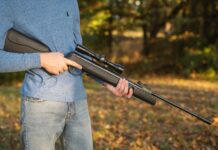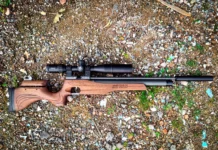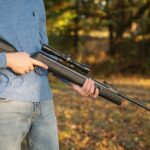By Trapline Editor Hal Sullivan
From left to right: Three sizes of coyote trap: No. 1.75 with 5 inches of jaw spread; No. 2 with 5-1/2 inches; No. 3 with 6-1/2 inches.
It’s a perennial question—how big of a trap do I need for coyotes? Seems like someone at every trapping convention I attend asks if he can catch coyotes with the No. 1.5 footholds he already owns and sets for fox and coon, and I hear countless tales of coyotes caught in No. 1.5 traps, all of which are no doubt true.
But if you set out to be a coyote trapper with a bunch of No. 1.5 traps, you’re just setting yourself up for disappointment. The trap is simply too small to be a reliable coyote catcher.
If you want to move up to coyote trapping, you need something a little bigger. That would be the No. 1.75 class of traps. Give or take a little, 1.75 traps have an inside jaw opening of about 5 inches. Some people think this still is too small for coyotes. I disagree. In fact, I catch a lot of coyotes with these traps. I do concede they are the smallest I would want to use for coyotes, and the relatively small jaw spread must be considered when making sets. If a coyote’s foot isn’t pretty much centered in a No. 1.75 when the trap fires, it isn’t going to get a good grip. I take precautions to prevent this.
Solid trap bedding is important with any trap, even more so when setting a trap of this size for a coyote. There’s a good chance the coyote might not step exactly on the trap pan, and if it steps on a jaw, instead, I don’t want that trap to wiggle, or, worse yet, flip up out of the bed.
A coyote is a heavy animal, and its foot exerts a lot of pressure. When I’m checking a bedded trap for stability, I don’t push gently on it, I push hard. If the trap moves, I adjust the bedding until it doesn’t. If a trap moves underfoot, a curious coyote is likely to stop working the set and instead dig up that trap.
I also make the trap bed as small as possible, so I don’t have to repack a lot of loose dirt outside the trap jaws. If this dirt isn’t packed in really well, a heavy-footed coyote may sink into the loose dirt, back off and start digging.
Truth is, you are going to have some misses with these small traps, when the coyote’s foot isn’t centered on the pan within the small radius of the jaws. The trick is not to arouse the coyote’s curiosity, or worse yet, spook it with a poorly bedded trap. If you don’t spook it or educate it, you might catch it on the next step or the next visit. The trick is to make sure everything stays in place until the coyote steps squarely on the trap pan.
I also put a significant amount of tension on the trap pan. If a trap is set exclusively for coyotes, I don’t want it to fire until 4 pounds of downward pressure is being applied by the animal’s foot.
If you’ve never set a trap with 4 pounds of pan tension, you may think it way too much. Four pounds is a lot of weight. You can set a half-gallon plastic jug of water on a trap pan with 4 pounds of tension, and it may not fire. But trust me, when the coyote shifts its weight to that foot, it will be pressing down harder than 4 pounds, and the trap will fire.
If I want to also have a shot at catching a fox, I may back off to 2 or 3 pounds.
This heavy pan tension serves two purposes. First, it prevents the trap firing if perchance the coyote just brushes the pan with the edge of its foot. No. 1.75 traps have a small enough jaw radius that a coyote’s foot may straddle a jaw and still touch the pan. You don’t want the trap to fire at that point, because it won’t get a good hold on the coyote’s foot, if it gets a hold at all. You not only want the coyote’s foot centered on the pan, you also want that foot to be pushing down hard before the trap fires.
Think of it like the diving board at the old swimmin’ hole. If the board is so rotten it breaks when you first touch it with a toe, you’ll still be balanced with your weight on your back foot and probably won’t fall in. But if the board has a little strength left, and you step all the way onto it before it breaks—down you go.
With heavy enough pan tension, by the time the pan breaks free, the coyote has committed enough weight that the foot falls, and the coyote can’t react quickly enough to pull that foot back out. It literally falls into the trap, which helps the little jaws get a better grab on its paw.
Foot guides are the final thing I apply at the set to get the coyote’s foot squarely centered in the trap. Foot guides are small objects placed outside of the set trap’s jaws to help steer the coyote’s foot directly onto the pan. Foot guides should be just big enough that a coyote would be uncomfortable stepping on top of them.
Don’t overdo it and build a wall around the trap. The foot guide is more a subtle hint, something the coyote notices and processes in the back of its mind, just as it does every other time it takes a step.
At a dirthole set, small clods in the dirt pattern make natural foot guides. Otherwise, stones no bigger than a golf ball, small sticks or other debris from nearby the set can be used.
I typically place three foot guides in a triangle around the trap, being careful not to locate any of them above the jaws or over the levers of the trap. Sometimes it’s helpful to put the guides in place before sifting the final covering of dirt or chaff over the set trap.
If a No. 1.75 gets a good grip on a coyote’s paw, it should hold that coyote. You can soup the trap up with four coils and other modifications, but a stock two-coil No. 1.75 should catch the average coyote and also make a pretty good trap for red fox, too, though it may be a little too much for the smaller grays.
If I’m trapping where I’m fairly certain I’m only going to catch coyotes, especially if I am being commissioned to remove said coyotes, I’m going to set a No. 2 trap, the next size up. In general, the No. 2 is a 5-1/2-inch trap as opposed to the No. 1.75, which is a 5-inch trap. A half-inch may not sound like much, but it can make a big difference in the way trap jaws catch and hold a coyote.
Just be aware that there is no industry-wide standard to the numbering system. Some No. 2 traps have a jaw spread no greater than some No. 1.75 traps.
You need to check for yourself.
Here, we also begin to hit legal restrictions on jaw spread. In Ohio, we are not allowed to set a trap on dry land that has an inside jaw measurement greater than 5.625 inches. I check to make sure each No. 2 trap has an inside jaw spread of at least 5.5 inches but no more than 5.625.
Again, buyer beware.
With the No. 2, we enter the realm of dedicated coyote traps, and since I set these traps specifically for coyotes, some of mine are outfitted with Paws-I-Trip, a replacement pan and dog system that produces 3 to 4 pounds of pan tension. It works on mechanical advantage. There is no bolt to tighten, and there is nothing to go out of adjustment.
Yes, it is slightly more tension than I want for a fox, but again, these traps are dedicated to coyotes, and I am not trying to catch fox with them.
When setting this larger trap, I still follow the same rules for careful bedding and foot guides as I follow when setting the No. 1.75. The half-inch of extra jaw spread just provides a bigger working area and an increased chance at getting a good across-the-pad catch on a coyote.
On the upper end of the range of coyote traps are the 6- to 6-1/2-inch traps. The numerical size means even less with traps of this size. It seems trap makers assign No. 3 and No. 4 designations almost at random. Some No. 3 traps are actually larger than some No. 4. Perhaps because of this, some manufacturers instead designate their traps by the actual measured jaw spread, for example 650 for a 6.5-inch trap.
I certainly applaud that choice.
I follow the same setting procedures and don’t think there is much need for a coyote trap larger than 6.5 inches. So, for me, that runs the gamut of coyote traps.
The No. 1.75 is as small as I want to go, but used carefully, it can make a very serviceable trap for coyote and also fox. Bigger traps are less appropriate for fox but better suited for coyotes. Know the law and then decide what is the best fit for you—as well as the local coyotes.










































